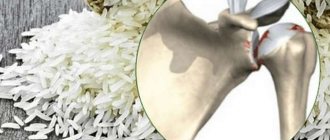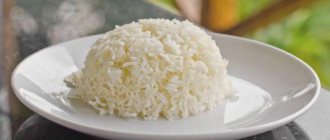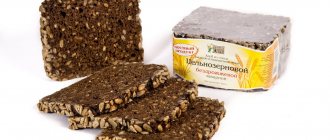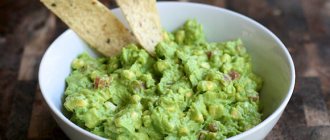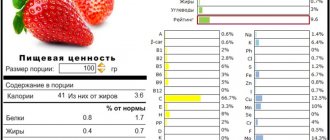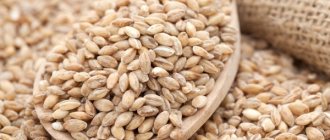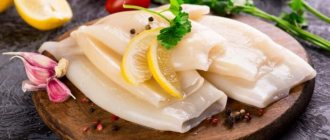For most residents of Russia, rice is associated with the white oblong grains that we see on store shelves. In fact, the variety of its types is like a color palette. A special place in this diversity is occupied by brown, also known as brown, unpolished rice. Taking into account its beneficial and dietary properties, availability and taste, such rice will be the best option for the daily diet and therapeutic nutrition.
In the article we will tell you what kind of rice it is and what its differences are, its chemical composition, benefits and harms, how to choose, prepare and store it correctly, recipes based on it and contraindications.
Brown rice: what is it?
This is whole grain rice with the inedible hull removed, but with a layer of bran and germ retained. Externally it has a rough surface and an unusual dark color. The grains themselves under the shell are light. The cereal does not undergo processing or purification, so it retains the mineral and vitamin complex given by nature. Due to the lack of the usual polishing process, brown rice is also called unpolished or unpolished.
In terms of taste, it is a little coarser in comparison with white, which is explained by the high content of plant fiber. It has a specific taste and requires more time to prepare - 20-40 minutes. But in the process of heat treatment, due to the preservation of the pityriasis shell, useful and nutrients are not lost, but are preserved in the structure of the grain.
Peculiarities
The advantages of such rice include the preservation in factory conditions of the peel and germ layer, which contain up to 10% protein, 85% oil, 70% mineral salts and cellulose, 80% vitamin B1. In other words, compared to white rice, brown rice is healthier for the body.
It is recommended to be used as an essential component of the daily, dietary and therapeutic diet.
Kinds
Such rice is distinguished by the shape and length of the grain: short or round (no more than 5 mm long), medium (5-6 mm), long grain (more than 6 mm).
Chemical composition, trace elements, vitamins
To understand the benefits of brown rice, let’s look at its composition. It contains a high concentration of carbohydrates: starch, sucrose, sugars, dextrins; amino acids and fatty acids, water, ash, and dietary fiber are also present.
Cereals include almost all B vitamins (thiamine, riboflavin, choline, pyridoxine, folate, pantothenic acid), vitamin E and K, and nicotinic acid. Microelements include calcium, potassium, magnesium, sodium, phosphorus, manganese, iron, selenium, copper, zinc.
KBZHU
Dry brown rice is characterized by high energy value (367 kcal per 100 g), high carbohydrate content (72.7 g), relative poverty of protein (7.2 g) and fat (3.2 g).
During heat treatment, the nutritional value and calorie content of boiled rice is reduced almost three times and is:
- calorie content - 123 kcal;
- proteins - 2.7 g;
- fats - 1 g;
- carbohydrates - 24 g.
How suitable for weight loss
Brown rice is considered a healthy and proper nutrition product; it is ideal for correcting and controlling body weight. You can lose weight by cleansing the body of waste and toxins, removing excess fluid from the body, due to which swelling subsides and centimeters go away.
Grains serve as a natural source of complex carbohydrates such as starch and fiber, which the body expends energy to digest. “Proper” carbohydrates are slowly absorbed by the body over a long period of time and give you strength for a long time.
Fiber in the stomach swells , so a person is able to get enough of a small portion and not experience hunger or the need for snacks for a long time. Pectin fibers help lower blood sugar levels, regulate cholesterol levels, and improve intestinal microflora.
There are many diet regimens based on brown rice. Depending on gastronomic preferences, desired results and finances, everyone will choose the best option. Some people prefer a quick but tough way to get rid of extra pounds in the form of fasting days or a strict mono-diet. For others, less hungry diets are a better choice.
According to reviews from those who have used brown rice for weight loss, the majority are satisfied with the result. Among the most common negative aspects are dizziness and nausea, which is often associated with hunger, constipation during a mono-diet and other difficulties in the digestive tract.
For reference. The maximum recorded weight loss results are 10 kg per week, but in most cases the result is lower - 3-7 kg, depending on the diet option and its duration.
Before starting any diet, if you have diabetes, diseases of the gastrointestinal tract or other organs, consult your doctor.
When losing weight
Brown rice helps restore health, lose weight and strengthen the body as a whole.
The dietary properties of the cereal are based on the high content of fiber and other biologically active substances, which stimulate intestinal activity and cleanse it of waste and toxins.
An excess of stagnant food masses in the intestines is the main cause of metabolic disorders, as a result of which a person gains excess weight and loses shape.
The formation of masses of such waste reaches ten to twelve kilograms, which appear when consuming refined foods, unhealthy foods and irregular nutrition. Food masses accumulating on the intestinal walls interfere with the absorption of vitamins and increase the number of dangerous microorganisms.
The calorie content of brown rice is high: 340 calories per 100 grams , and when boiled, this figure decreases almost three times - so this cereal is a priority for those who want to lose weight.
Brown rice quickly saturates, and at the same time the body receives many useful substances. Taking into account all the beneficial properties of brown rice, it is worth including it in your diet. By following a rice diet for a month, which includes completely replacing potatoes, pasta and white rice with unrefined grains, you can lose three to five kilograms of weight: your metabolism and appearance will significantly improve.
Nutritionists recommend eating brown rice two or three times a week - in this case, the body receives the required amount of nutrients contained in the grain. The most optimal and healthy combination in the rice diet is considered to be brown rice with vegetables.
HELP: you shouldn’t over-salt a rice dish, it’s better to add a minimum of salt, and a salt-free diet allows you to quickly get rid of fat rolls without compromising your health.
Beneficial properties for the human body
The rich composition of unpolished rice becomes an assistant in the treatment and prevention of a wide range of diseases and improves well-being. The cereal serves as a source of vitamins E, K, group B, and mineral salts, which give beauty and longevity.
Scientists have found that people whose diet includes 5-6 rice-based dishes are less likely to experience obesity, skin diseases, and are 20% less at risk of heart pathologies.
Rice serves as a good prevention of diseases of the cardiovascular system:
- normalizes blood circulation processes;
- reduces cholesterol levels in the blood;
- participates in hematopoiesis;
- increases the strength and elasticity of vascular walls, reduces their permeability.
Consuming brown rice in moderation helps control blood sugar levels, thereby reducing the likelihood of diabetes.
Brown rice is a natural enterosorbent , which cleanses the liver, kidneys and blood of toxic substances, and removes undigested foods and toxins from the intestines. The high potassium content of grains helps remove excess fluid from the body. This property helps people prone to edema, hypertension, coronary heart failure, and impaired renal excretory function.
Its absorbent qualities are beneficial in the treatment of diseases of the skeletal system. The active components of the cereal promote the dissolution and removal of salts, which improves the prognosis of arthritis, arthrosis, osteochondrosis, and prevents relapses and complications.
The protein contained in unrefined cereals serves as the main material for the construction of cells, tissues, organs, the formation of enzymes and hormones, and plays an important role in the metabolism of fats, carbohydrates, vitamins, and mineral salts.
Regular consumption of such rice has a beneficial effect on the condition and functionality of the digestive organs. Cereal improves the functioning of the gastrointestinal tract, normalizes metabolism, activates lipolysis (the process of fat breakdown), fills the body with energy, and enhances intestinal motility. This product is extremely useful for diarrhea and obesity.
Due to its ability to reduce acidity and coat damaged mucous membranes, rice is recommended for consumption by people suffering from gastrointestinal diseases of an erosive and ulcerative nature.
B vitamins are beneficial for the nervous system: they relieve irritability, reduce the effects of stress, relieve insomnia, stimulate thinking processes, improve memory and concentration.
BROWN RICE - BENEFITS AND HARMS | brown unpolished rice, benefits of unpolished rice,
For diabetics
Brown rice can be useful for most chronic diseases: the grain can be used for the prevention and treatment of gastritis and diabetes . With proper and moderate consumption of brown rice, it is possible to regulate blood sugar levels, which is important for diabetes. This cereal does not contain gluten, a plant protein that is very often a source of food allergies. People who are intolerant to wheat gluten can safely use brown rice.
REFERENCE: the price of brown rice is high, so it is worth remembering that a low price may be a signal of low quality of the product.
What is brown rice used for?
Brown rice is widely used in cooking for preparing first, second and sweet dishes. They simply replace regular rice. It is used to prepare pilaf, side dishes, casseroles, puddings, and pie filling.
Unrefined rice cereal is prescribed as a therapeutic food for diseases of the musculoskeletal system, heart and blood vessels, for the prevention of diabetes, kidney failure, and hypertension. A decoction or infusion of rice is used as a medicine, which is highly valued for its mild enveloping effect on the digestive organs and its absorbent qualities.
Cooking in a slow cooker or double boiler
A multicooker and a steamer are unique household appliances. With their help, cooking brown rice is easy, and the results are excellent. Here are some tips on how to properly cook brown rice in these “miracle pots.”
The process of preparing cereals is no different. After washing and soaking, transfer the rice to a multi- or steamer bowl. The multicooker has a “Rice” and/or “Pilaf” mode. That's what we need. We turn it on and wait for the ready signal.
All models of steamers have a container for boiling rice. Pour a small amount of water into it. Due to the hardness of the grains, you will have to add very little water to the same bowl; steam alone will not be enough. Half an hour in the steamer and the rice is ready.
Now you know all the secrets of how to cook brown rice correctly. Bon appetit and be healthy!
Brown Rice Recipes
The variety of options for dishes based on brown rice is amazing. With their help, you can not only lose weight, but also improve the health of the entire body, improve the functionality of internal organs and systems. Below we will tell you how to cook brown rice with vegetables, rice soup and meatballs.
Rice soup
You will need:
- water – 1.2-1.5 l;
- brown rice – 50 g;
- celery – 300 g;
- bell pepper – 1 pc.;
- tomatoes – 2 pcs. medium size;
- Chinese cabbage – 200 g;
- garlic – 1 clove;
- onion – 1 pc.;
- vegetable oil to a minimum;
- parsley, herbs to taste.
How to cook:
- Rinse the rice until the water is clear, soak in cold water for 6-8 hours, preferably overnight. In the morning, drain the water and rinse well again with running water.
- Pour cold water into the pan, add the cereal, cook after boiling over medium heat for 20-25 minutes.
- Fry finely chopped garlic in a small amount of vegetable oil, after 2-3 minutes add chopped celery and onion. Fry with garlic.
- Pour boiling water over the tomatoes, remove the skins and chop finely.
- Chop the cabbage, chop the bell pepper into small pieces.
- Add frying and vegetables to the pan with rice. After the water boils, cook all the ingredients together for 5-10 minutes.
- At the end, add salt to taste, add herbs and, if desired, chili pepper rings.
Recipe: Brown Rice and Green Bean Soup
Lenten rice meatballs
Ingredients:
- minced beef or chicken – 0.5 kg;
- brown rice – 200 g;
- onions – 1 pc.;
- carrots – 1 pc.;
- eggs – 2 pcs.;
- tomato juice – 250 ml;
- olive oil – 2 tbsp.
How to cook diet meatballs with rice:
- Rinse the rice until the water is clear, and steam with boiling water for 20-30 minutes.
- Add finely chopped onion, coarsely grated carrots, eggs, salt and pepper to taste, rice to the minced meat. Mix everything well.
- With wet hands, form into medium-sized balls. Fry in a small amount of vegetable oil until golden brown.
- Adjust tomato juice to taste by adding salt, suneli hops and other spices.
- Place the meatballs in a saucepan and pour in tomato juice. Simmer over low heat, covered, for 25-35 minutes.
- Serve with a side dish or as a separate dish.
Rice with vegetables
You will need:
- brown brown rice – 1 cup;
- bell pepper – 2 pcs.;
- carrots – 1 pc.;
- tomatoes – 2 pcs.;
- garlic – 2 cloves;
- green onions to taste;
- vegetable oil;
- soy sauce.
Recipe:
- Boil brown rice until tender, soaking it overnight.
- Pour boiling water over the tomatoes, remove the skins and cut into small cubes.
- In a small amount of vegetable oil, fry finely chopped garlic, pepper strips and shredded carrots. At the end of cooking, add tomatoes and herbs. Cook all vegetables together for another 5 minutes. Remove from heat.
- In a separate container, mix boiled rice and vegetables. Season with soy sauce if desired.
Recipes
Brown rice takes a little longer to cook than white rice. You can prepare the product in several ways:
- In a saucepan. For 1 cup of rice you will need 2.5 cups of water. It must be remembered that after cooking the volume of grains increases three times. Water with rice should be salted and cooked for 40-50 minutes, stirring, until the product becomes soft.
- In the oven. After pre-soaking, place the grains in a baking dish. In a separate saucepan, mix water (2.5 cups), a spoonful of sunflower oil, a little salt and bring to a boil. Add the boiling mixture to the rice, cover with foil and cook for an hour until the cereal is soft.
- In the microwave. Pour 3 cups of water into a bowl, add a cup of grain and 1 tbsp. l. sunflower oil. Microwave, uncovered, for 10 minutes. Then cover the container and cook for another half hour.
- In a slow cooker. This recipe is considered one of the simplest. In order for the side dish to be crumbly, the rice must be thoroughly washed, placed in a multicooker bowl, filled with water and salt. Set the “Rice” program in the menu and cook for about half an hour.
How to cook properly
Cooking brown rice involves pre-soaking the grain so that the grain is completely cooked.
One of the simple options is this. Rinse the rice until the water is clear and soak in cold water overnight. In the morning, drain the water and rinse the cereal again. Then boil for 10 minutes, rinse with cold water. After this, pour cold water over the cereal and cook over low heat for 25-40 minutes. Check the readiness of the grain by taste.
Using a colander, strain the liquid, season the finished porridge with lemon juice, natural vegetable oil, and soy sauce if desired.
Rice according to this recipe turns out tasty, has a pleasant nutty aroma, cooks evenly and retains its crispness.
Possible health hazards
However, there are restrictions for eating brown rice:
- It is recommended to eat it no more than 2-3 times a week.
- A single serving for women is no more than 200 g of boiled rice. The amount of rice serving for men should not exceed 250 g.
- Brown rice is not recommended for young children because... may irritate the intestines.
- It is not advisable to eat it during increased flatulence or exacerbation of stomach diseases.
Such prescriptions are due to the presence of a large amount of fiber in this cereal. In addition, for this reason, brown rice can cause increased gas formation in the intestines. However, it perfectly helps fight constipation, provided that you drink enough water.
To avoid undesirable consequences, you need to properly process the cereal before cooking.
- First, it is washed in cold water.
- Then soak for at least 30 minutes.
- Wash again.
- Pour rice into boiling water in the proportion of 1 cup of cereal to 2 cups of water.
The average cooking time is 20-25 minutes after boiling, and this is done over low heat under a lid. If you want the water in the rice to be completely absorbed, then you need to maintain a proportion of 2 parts liquid and 1 part cereal. You can make the porridge more viscous - to do this, cook the rice in a large amount of water, then drain it, and place the cereal in a colander.
The porridge to which oil has been added should stand covered in a warm place.
You can prepare well-soaked cereal using a slow cooker or oven.
Rules for selection and storage
When buying cereal, pay attention to the expiration date. The average shelf life of such rice is 12 months. With longer storage, there is a possibility that the rice oil contained in the outer shell of the grain will go rancid, and the grain will develop an unpleasant specific odor. It will become unfit for consumption.
If the manufacturer indicates a shelf life of more than 12 months, most likely the grains were additionally subjected to chemical treatment, which increases their shelf life but reduces their beneficial properties. Try to take premium quality grains from a well-known, trusted manufacturer. To evaluate the appearance and quality of grain, determine the absence of foreign impurities and cereal bugs, choose rice in transparent packaging.
To preserve the smell and taste, after opening the package, pour the cereal into a clean glass, ceramic or plastic container with a lid. Store it in the pantry or kitchen cabinet, next to other grains.
It is undesirable for spices, seasonings, and other products with a pronounced odor to be nearby, since rice grains absorb foreign odors well.
Advice . To avoid the appearance of insect pests in the cereal, place your choice of bay leaf, dry capsicum, dried lemon or orange zest, and mint sprigs in a container with rice.
The optimal storage temperature for rice is 5-15°C, the humidity level is not higher than 75%.
High temperature, excessive humidity, and direct sunlight expose the grains to irreversible changes - oxidation of the oils contained in the pityriasis shell, after which the use of such a product can threaten health. Also, high temperatures create favorable conditions for the formation of mold and the appearance of cereal bugs.
Dry rice can be stored in the refrigerator and freezer . The cereal must first be poured into plastic bags or special plastic containers with a tight-fitting lid.
Cooked rice can be stored in the refrigerator for no more than 72 hours, in the freezer for up to three months.
Composition, calorie content and features of brown rice
Brown and white rice are the same grain.
White is subjected to grinding, depriving the grain of the most valuable thing - the shell and the embryo.
For what? The secret is simple - the refined product lasts longer.
Brown has a shorter shelf life, its price is significantly higher, but the benefits for the body are much greater.
The shell of the brown cereal itself is fiber, which is important for intestinal function.
It contains a unique complex of amino acids, vitamins and microelements that are important for maintaining our health. Energy ratio of this product: 7:11:78 (used). The calorie content of brown rice in its raw form is lower than that of its white “brother” - 331 kcal. When cooked it will be no more than 100 kcal . That is why brown rice must be included in the list of products for all adherents of a healthy lifestyle when going to the store.
What can you replace brown rice with?
Brown rice can be replaced with red or black rice. They have similar properties and a pityriasis-like shell. The downside is their high cost.
Then white parboiled rice is recommended as an alternative. Positive characteristics of grain are achieved through technological processing, which consists of steaming whole grains without removing the outer shell. Under the pressure of the hot season, useful substances pass directly into the grain itself.
Rice can be replaced with any cereal - buckwheat, pearl barley, millet, oats, rye, wheat, corn grits. All of them are rich in complex carbohydrates, but the mineral and vitamin complex is different, so they are not considered completely interchangeable.
Why else should you consume brown rice?
- It contains a large amount of manganese, which is involved in the production of energy from carbohydrates and proteins. In addition, it plays a key role in the synthesis of fatty acids necessary for a healthy nervous system.
- Brown rice is a source of selenium, which inhibits the development of cancer cells. In addition, this microelement strengthens the immune system and activates the body's protective functions.
- It contains a large amount of phenolic resins, which have anti-inflammatory properties.
- As a source of magnesium, brown rice is important for strong bones, since the bulk of this mineral accumulates in bone tissue.
Possible harm and contraindications
With frequent consumption of large portions of cereal, there is a high likelihood of constipation, a feeling of heaviness in the stomach, and bloating.
Eating large portions of cereal impairs the absorption of potassium, calcium and magnesium, which adversely affects the state of the cardiovascular system and can disrupt the functionality of the heart muscle and endocrine glands, leading to a decrease in the strength of bone tissue.
For reference. A mono-diet based on brown rice may be accompanied by dizziness, headache, nausea, and hunger.
An absolute contraindication for eating rice is an allergy to the product. Cereal-based dishes are excluded for people suffering from constipation, arterial hypotension, and severe heart and vascular diseases.
It is necessary to consume cereals with caution if there are large stones in the urinary system. A pronounced diuretic effect can provoke the movement of stones, which causes pain and can lead to disruption of urodynamics, complete or partial blockage of the urinary tract with subsequent kidney damage.
Video about the benefits of brown rice
This video tells you more about the unique healing qualities of brown rice:
Irina Polyanitsa My name is Irina, I am the owner and admin of the site, as well as the author of most of the recipes and articles. I love to cook simple and healthy delicacies. Certified gym instructor, personal trainer. She completed a course on nutrition and health at Stanford University, Stanford Introduction to Food and Health, as well as a course at Ludwig Maximilian University of Munich (LMU) Nutrition and Lifestyle in Pregnancy (about nutrition and lifestyle during pregnancy).
How to prepare diet meals from brown rice for losing weight
Options for delicious brown rice dishes recommended by nutritionists for those who want to lose weight:
- Salad “Spring mood”. Half a kilogram of shrimp is boiled and peeled. Melt a small amount of butter in a deep frying pan (approximately 1 tsp), add waste from peeling shrimp (heads, tails, shells) and small chopped carrots, parsley stems, and a glass of dry white wine. The mixture is brought to a boil. Separately, 2 medium chopped onions are fried in olive oil until transparent, add 1 cup of rice to them and fry with the onion for several minutes until the rice grains also become transparent. The strained broth from the shells is poured into a frying pan with rice, and everything is boiled together for about 20 minutes in an open container until the rice is ready. Rice is served with boiled shrimp, halves of boiled quail eggs, green onions, and parsley.
- Stuffed eggplants. Bake the eggplant halves in the oven at 200°C until cooked. Depending on the size of the eggplants, this will take 20 to 30 minutes. Fry chopped bell peppers, apples, carrots, and garlic in oil until half cooked. Add a glass of brown rice and chopped pulp of baked eggplants to the fried vegetables. Fill the eggplant halves with the resulting rice and vegetable mince and place in the oven for 15 minutes at 220°C. Served with herbs and fresh tomatoes.
Diet cabbage rolls. A glass of brown rice is boiled until half cooked. Fresh cabbage leaves are separated from the head and boiled until half cooked. Chopped onions (3 heads) are fried until golden brown in olive or sunflower oil.
Raw chicken breast (1 kg) is passed through a meat grinder, mixed with rice, fried onions, and 1 raw egg is added to the minced meat. The cabbage rolls are formed and placed in a baking dish.
Mix a glass of tomato paste in 300 ml of hot water, add a pinch of salt and ground black pepper. Stuffed cabbage rolls are filled with tomato sauce and placed in the oven for 40 minutes. Cooking temperature – 180 °C. Serve diet cabbage rolls with low-fat yogurt.
Brown rice calories
Brown rice cannot be called a low-calorie product. 100 g of this product when boiled contains 110 kcal. However, brown rice not only benefits the body, but is also used for weight loss.
The weight loss effect is achieved due to the properties of brown rice to accelerate metabolism in the human body. Eating it allows you to reduce weight by 3-4 kg per week.
